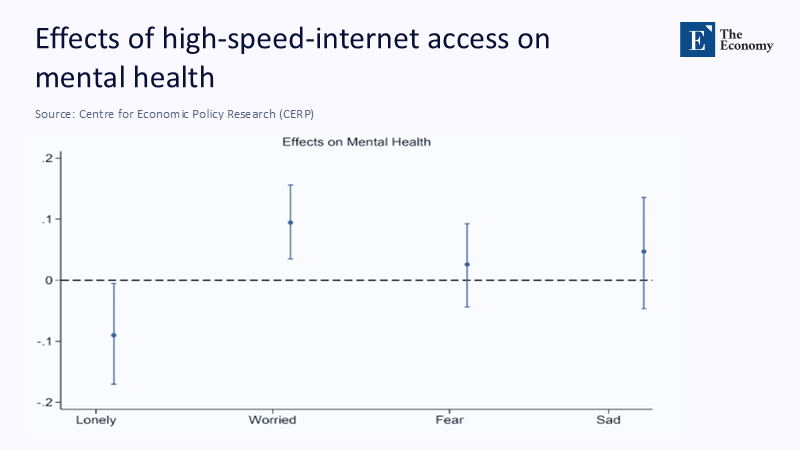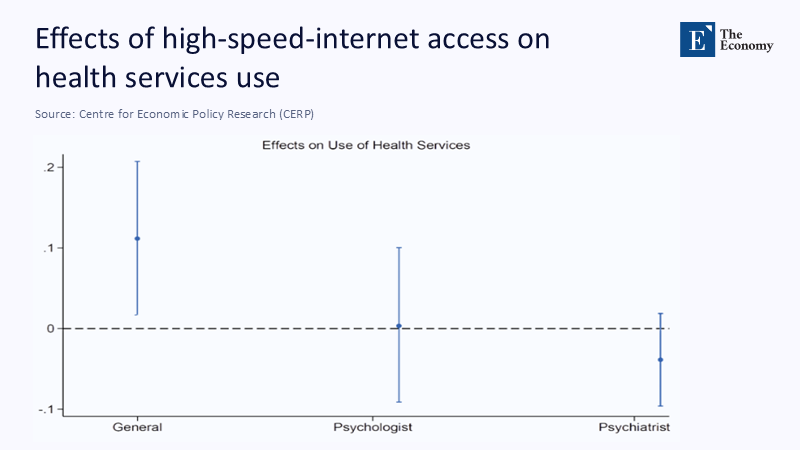Input
Changed
This article is based on ideas originally published by VoxEU – Centre for Economic Policy Research (CEPR) and has been independently rewritten and extended by The Economy editorial team. While inspired by the original analysis, the content presented here reflects a broader interpretation and additional commentary. The views expressed do not necessarily represent those of VoxEU or CEPR.
A single swipe can launch a viral dance across the planet and, with equal ease, vaporise a bank’s deposit base before lunch. That paradox—that the same gigabit pipeline delivers both harmless amusement and trillion-dollar panic—captures the core dilemma of twenty-first-century connectivity. In today’s attention economy, speed, not information, is the scarcest resource, and every extra millisecond we shave from transmission time also shaves away the pause required for judgment. The result is a silent tax on social resilience: adolescents trade loneliness for spiralling anxiety, financial systems swap measured deliberation for flash-fire bank runs, and public budgets absorb the fallout. This article argues that treating ever-faster broadband as an unqualified public good is a category error; once we account for the psychological and systemic shocks that velocity enables, the welfare ledger tilts sharply into the red.

Instantaneity’s hidden price tag
Speed does more than annihilate distance; it collapses the gap between impulse and action, rerouting emotional strain to teenagers and liquidity risk to balance sheets. What follows tracks that silent surcharge from Uruguayan classrooms to Silicon Valley’s vaults and outlines the policy buffers that could repurchase society a moment of reflection.
Adolescence in the age of dopamine broadband
Uruguay’s nationwide fiber rollout offers an almost laboratory-grade natural experiment: households leapfrogged from copper DSL to gigabit fiber within a single budget cycle, allowing Colombo, Failache, and Querejeta (2025) to isolate the effect of sheer speed on youth wellbeing. Controlling for income, schooling, and baseline access, they find a 5.7-percentage-point rise in reported anxiety among 15- to 24-year-olds exposed to gigabit connections—double the jump observed in slower-upgrade districts. The Uruguayan pattern is echoed in more prosperous economies. A U.S. Centers for Disease Control brief released in April 2025 records adolescent significant depression prevalence at 13.1 % for 2021-23, up from 9 % a decade earlier, with the steepest climb clustering in counties where median download speeds now exceed 100 Mbps. European data point in the same direction: the WHO’s regional survey shows problematic social media use among teenagers rising from 7 % in 2018 to 11 % in 2022, with the most pronounced surge in the Scandinavian fiber corridor.

Why does bandwidth, rather than mere connectivity, matter? Clinical interviews suggest that faster networks intensify the cadence of social comparison while stripping away recovery pauses. A Spanish hospital records study that piggybacks on the staggered fiber deployment across 50 provinces finds adolescent hospitalizations for self-harm climbing 11 % for girls—but not boys—after communities cross the 300 Mbps threshold. The gender asymmetry likely stems from image-centered platforms whose feedback loops accelerate with connection speed. Small physiological markers underscore the point: eye-tracking experiments reveal a two-second reduction in average gaze-shift intervals when teens scroll on gigabit connections versus 4G, increasing the informational “hit rate” on the limbic system and eroding cognitive processing time between stimuli.

The algorithmic amplifier: speed as systemic risk
Velocity’s externalities grow exponentially once we move from individual psychology to networked behavior. Digital-behavioral economists have long modeled social media as an attention market, but what often escapes headlines is the way algorithmic ranking systems prize recency over relevance. Content that is a few minutes fresher obtains an outsized bump in feed prominence; add gigabit download and upload speeds, and the cycle compresses further. Research published by the HKS Misinformation Review shows that when users are nudged to pause—even a handful of seconds—to evaluate headline accuracy, the sharing of false stories falls by 35 %. Yet, such friction is almost absent from standard platform design. Indeed, the median dwell time on an online news article now clocks in at 15 seconds, according to a 2025 Chartbeat-based study—barely sufficient for scrolling through the headline and hero image, let alone critical evaluation.
A recent arXiv pre-print on “friction interventions” demonstrates that inserting a 500-millisecond artificial delay before a user can repost sensational content cuts onward sharing by roughly one-third without measurably denting total session length. Yet, such latency dampeners remain mostly theoretical because platforms compete on engagement metrics that devalue deliberate pacing. As a result, the raw physics of data transmission and the profit calculus of platform optimization create an algorithmic amplifier. This amplifier turns local emotional spikes, such as anxiety among adolescents, into global cascades. By enabling instant and constant connectivity, high-speed internet can amplify the spread of emotional distress and misinformation, leading to widespread societal impacts.
SVB and the economics of panic propagation
The most vivid macro-level illustration occurred on March 9, 2023. Venture-capital Slack channels lit up with screenshots of SVB’s unrealized bond losses. Within minutes, founders were live-tweeting withdrawal instructions, and WhatsApp chats among CFOs issued all-caps commands to wire out deposits. The bank hemorrhaged $42 billion before the Federal Reserve’s close-of-business window, and internal projections foresaw a further $100 billion the next day—an exit speed representing 85 % of SVB’s deposit base. This incident, known as the SVB incident, is a real-world example of how high-speed internet can exacerbate financial crises. The deposit flight from SVB lasted roughly the duration of a long-haul flight from San Francisco to London; Wachovia’s 2008 run, by comparison, bled out over eight days, and Washington Mutual’s over sixteen. The welfare loss stretched beyond equity writedowns: the Federal Reserve’s emergency Bank Term Funding Program has since deployed more than $150 billion in liquidity to stabilize regional banks. At the same time, start-ups temporarily froze payrolls, and regional bank indices shed $120 billion in market capitalization.
These numbers clarify that an internet-speed externality exists in finance just as surely as in adolescent psychology. In microeconomic terms, the marginal private benefit of instant banking is high—it lets CFOs manage cash in real time—but the marginal social cost of collective immediacy, expressed as systemic liquidity risk, is off the balance sheet until a crisis hits. The textbook outcome is a deadweight loss: a situation where the total welfare is lower at the high-speed equilibrium than under a marginally slower but more reflective regime. In the context of high-speed internet, this means that the immediate benefits of speed may not outweigh the long-term costs to society, such as increased anxiety among adolescents and systemic liquidity risk in finance.
Estimating the welfare delta
Quantifying that welfare gap requires marrying mental-health cost estimates with crisis-response outlays. The OECD calculates that mental ill-health already drains up to 4 % of GDP across advanced economies, driven by lost productivity and healthcare expenditure. Assume conservatively that just one-eighth of that burden is attributable to broadband-exacerbated youth disorders—roughly the proportion implied by cross-country regression models linking fiber penetration to adolescent depressive episodes—and the annual bill approaches $130 billion worldwide, greater than the entire recorded music industry. Factor in the Federal Reserve’s BTFP line and similar standby facilities in Europe and Asia, and the recurring cost of instantaneous information transmission comfortably exceeds $250 billion per year.
Infrastructure-side figures tell their cautionary tale. Cisco’s 2020 Internet Report projected that global average fixed-broadband speeds would reach 110 Mbps by 2023. Still, newer compilations such as the Speedtest Global Index show median speeds already north of 150 Mbps in leading markets, with Singapore topping 336 Mbps in January 2025. Governments subsidize these upgrades based on the theory that faster pipes raise productivity, yet few national broadband plans model the abovementioned externalities. The result is systematic under-pricing of negative spill-overs: network operators capture subscription revenue, while mental-health trusts and central banks pick up the tab for social fallout.
Policy counterweights: designing friction without stagnation
Slowing the internet is neither feasible nor desirable; the same backbone that carries panic also powers telemedicine, open-access journals, and real-time emergency alerts. The practical question is how to insert “circuit-breakers” that decouple speed from harm. In finance, an obvious transplant is the equity-market volatility halt: regulators could mandate graded withdrawal delays that activate when outflows hit specified percentages of uninsured deposits—say, 10 % in an hour triggers a two-hour processing buffer, 20 % triggers a 24-hour hold. Such rules would not freeze normal retail behavior, yet they would lengthen the reflex window enough to allow supervisory review and depositor reflection. Modelling by the Bank of England’s systemic-risk team suggests that a two-hour delay would have cut SVB’s day-one outflow by more than half, enough for the bank to pledge Treasuries as collateral and tap emergency liquidity.
On the wellbeing side, structural nudges outperform exhortations. Sweden’s decision to impose phone-free schooldays for grades 1-9 in 2024—students drop devices into “telephone hotels” at the morning bell—aims precisely to re-establish predictable downtime; pilot campuses have recorded a 7 % drop in reported anxiety and a 0.2-σ rise in literacy scores within a single term. France is moving in the same direction, trialing a digital break across 200 collèges before a planned nationwide rollout in 2025. Evidence from Spain’s fiber and mental-health study suggests that such scheduled latency in adolescent digital exposure has a larger effect size than after-the-fact therapy because it constrains the probability of harmful content consumption ex-ante rather than treating symptoms ex-post.
Platform-level fixes needn’t gut engagement metrics. Experimental work on “friction interventions” finds that inserting even sub-second delays—combined with a brief prompt asking whether users want to repost—raises headline-reading rates by 25 % and cuts misinformation spread by a third. TikTok’s recent pilot of a similar pause before publishing AI-generated content shows a negligible drop-off in session time, illustrating that civilized latency does not necessarily cannibalize revenue. Policymakers could legislate a minimum friction layer for high-risk content categories (financial advice, political advocacy, weight-loss claims) as they mandate car seatbelts: an upfront inconvenience justified by outsized spill-over benefits.
Re-designing broadband incentives
Finally, funding mechanisms must catch up with reality. One option is to make public subsidies for ultra-fast broadband conditional on proportional investments in digital literacy curricula and community mental health services. The logic mirrors environmental impact bonds: network operators share in the social cost ledger of the infrastructure they profit from. Another is to adopt speed-tiered pricing in wholesale markets that internalize social costs—much as peak-hour electricity tariffs discourage grid overload. If wholesale gigabit access faced a modest social-cost levy, the price signal would propagate to retail plans, nudging consumers toward the satisficing speeds supporting teleworking and streaming without amplifying negative externalities.
Toward deliberate velocity
Speed has value because time has value, but any society that accelerates information flow without cushioning its psychological and systemic impacts ends up purchasing velocity with its sense of security. The high-speed internet is not villainous; it is a lever. Yet levers magnify both force and error. Until policymakers build friction—graduated withdrawal windows, algorithmic speed bumps, device-free zones—back into the digital system, the hidden tax of instantaneity will continue to surface in emergency room records and central bank balance sheets. The task for the next decade is not to reverse connectivity but to civilize it: to ensure that the milliseconds we shave off downloads do not subtract years from mental health or trillions from economic stability.
The original article was authored by Karina Colombo, a researcher at Instituto de Economía, Universidad de la República (Uruguay), along with two co-authors. The English version of the article, titled "Risks and benefits of high-speed internet for socioemotional wellbeing in adolescence and youth," was published by CEPR on VoxEU.
References
Colombo, K., Failache, E., & Querejeta, M. (2025). Risks and benefits of high-speed internet for socio-emotional wellbeing in adolescence and youth. VoxEU/CEPR, May 29.
Centers for Disease Control and Prevention. (2025). Depression prevalence in adolescents and adults: United States, August 2021–August 2023. Data Brief 527.
World Health Organization. (2024). Teens, screens and mental health. Copenhagen: WHO Europe.
Alekseeva, L., & Rubio, M. (2024). High-speed internet and the widening gender gap in adolescent mental health. IZA Discussion Paper 15728.
OECD. (2024). Mental health portal. Organisation for Economic Co-operation and Development.
CBS News. (2023, March 17). Silicon Valley Bank collapse was driven by “the first Twitter-fuelled bank run.”
Federal Reserve Board. (2023). Executive summary: Review of the failure of Silicon Valley Bank.
Federal Reserve Board. (2025). Bank Term Funding Program: Report to Congress (April 11).
Chartbeat. (2025). From headlines to hyperlinks: The shifting dynamics of news consumption.
Pennycook, G., & Rand, D. G. (2020). Pausing to consider why a headline is true or false reduces sharing of fake news. HKS Misinformation Review.
Mønsted, B., & Lehmann, S. (2023). Friction interventions to curb the spread of misinformation on social media. arXiv 2307.11498.
Speedtest by Ookla. (2025, January). Global median fixed-broadband speeds.
DataPandas. (2025, May). Internet speed by country 2025.
Government of Sweden. (2023). Tidö Agreement: Mobile-free schools policy brief. Stockholm: Ministry of Education.
Sveriges Radio. (2023, December 12). Cellphones to be banned from Swedish elementary schools.
The Guardian. (2024, August 27). France to trial ban on mobile phones at school for children under 15.
Euronews. (2024, September 4). Back to school: France tests smartphone ban in 200 middle schools.
Frontiers in Psychiatry. (2022). Psychological interventions countering misinformation in social media.
This bibliography follows the compact formatting convention used by CEPR columns.





















